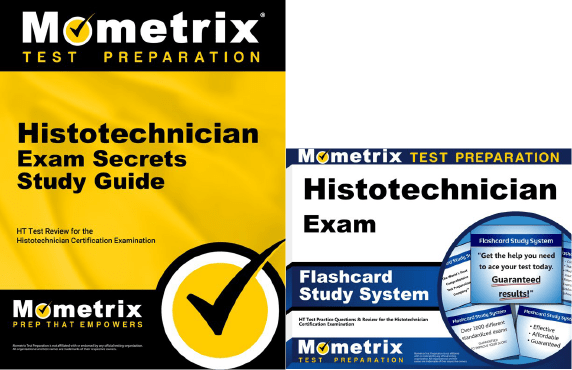If you need help studying for the ASCP Histotechnician exam or just want some more information about what the exam is like, you’ve come to the right place.
Click below to take a free Histotechnician practice test!
Exam Eligibility
Before you can register to take the exam, you’ll have to meet the requirements in at least one of the eligibility routes below:
- You need to have completed a histotechnician program within the last five years.
- You need at least 60 semester hours of academic credit or have an associate degree from an accredited college/university. In either case, you need a combination of 12 semester hours (18 quarter hours) in biology and chemistry. You also need to have at least one year of full-time histopathology lab experience within the last five years.
- You need at least 60 semester hours of academic credit or have an associate degree from an accredited college/university. In either case, you need a combination of 12 semester hours (18 quarter hours) in biology and chemistry. You also need to have completed a 50-week military histotechnician training course within the last 10 years.
If you meet one of these requirements, you’re set to begin the registration process!
What’s on the Exam?
There are 100 multiple-choice questions total and the time limit for the exam is 2.5 hours. There aren’t any scheduled breaks, but you’re free to take restroom breaks as needed.
The exam itself is split into five sections, but the questions on the exam are further grouped into one of eight topics:
- Tissues
- Procedures
- Parameters
- Reagents
- Instrumentation
- Mounting procedures
- Safety
- Lab mathematics
Let’s take a closer look at the different sections of the Histotechnician exam.
1. FIXATION
15%-25% of the exam
- Light microscopy
- Artifacts/precipitates/pigments
- Quality control
- Cytologic specimens
- In situ hybridization
- Frozen sections/tissues
- Enzyme histochemistry
- Immunofluorescence
- Electron microscopy
- Special stains
- Immunohistochemistry
2. PROCESSING
10%-20% of the exam
- Light microscopy
- Quality control
- Cytologic specimens
- In situ hybridization
- Frozen sections/tissues
- Calcified/decalcified tissue
- Enzyme histochemistry
- Immunofluorescence
- Immunohistochemistry
3. EMBEDDING/MICROTOMY
15%-25% of the exam
- Paraffin
- Quality control
- Frozen section
- Gelatin and adhesive
4. STAINING
30%-40% of the exam
- Carbohydrates
- Connective/supporting tissue
- Pigments, minerals, and granules
- Tissues and cells, as well as their components
- Quality control
- Nucleus/cytoplasm
- Bone marrow
- Cytological stains
- Lipids
- Microorganisms
- Nerve
5. LABORATORY OPERATIONS
10%-15% of the exam
- Molar solutions
- Percent solutions/dilutions
- The metric system
Stains Covered on the Exam
Here’s a list of most of the stains you’ll encounter on the exam:
- Alcian blue
- Alcian blue-PAS
- Alcian yellow
- Bielschowsky
- Carbol-fuchsin
- Colloidal iron
- Congo red
- Crystal violet
- Enzyme histochemistry
- Fontana-Masson
- Giemsa
- Gram
- Grocott/Gomori methenamine-silver
- Melanin bleach
- Hematoxylin and eosin
- Immunohistochemical stains
- Immunofluorescence
- In situ hybridization
- Luxol fast blue
- Movat pentachrome
- Mucicarmine
- Oil red O
- Papanicolaou
- PAS-digestion
- PAS-hematoxylin
- Periodic acid-methenamine silver/Jones
- Periodic acid-Schiff
- Prussian blue
- Reticulin/reticulum
- Rhodanine
- Romanowsky
- Spirochete
- Toluidine blue
- Trichrome
- Verhoeff-van Gieson
- von Kossa
Computer-Adaptive Testing (CAT)
The Histotechnician exam is a computer-adaptive test. Basically, this means that the questions will become harder or easier as you go through the exam, based on how well you’re answering the questions.
For example, say you answered the first question correctly. The first question is of medium difficulty, so the next question will be slightly harder. Then, let’s say you answered the second question incorrectly. The next question would then be a medium question.
How to Register
Once you’ve ensured that you meet all of the eligibility requirements, you can register for the exam!
To get started, you’ll need to submit an application on ASCP’s website. The application will ask you for your contact information and any documentation to prove your eligibility (among other things).
When you submit the application, you’ll also need to submit the $225 application fee.
Once your application is approved, you should receive an Authorization to Test (ATT), which will allow you to set up a testing appointment.
Exam Scores
The Histotechnician test is scored using a scaled scoring method. Here’s how it works:
You will need a score of 400 to pass the test.
The reason your raw score is converted to a scaled score is because everyone who takes the test is given a slightly different set of questions. Since everyone has a different arrangement of questions, and because some questions are harder than others, converting your raw score to a scaled score ensures a more even playing field.
If you pass, you’ll get a certificate mailed to you within a couple of weeks!
Retaking the Exam
If you didn’t get a passing score on your first try, that’s okay! You can retake the test after a 90-day waiting period. Just keep in mind that you will have to pay the full testing fee every time you retake the test.
If you take the exam five times without passing, you won’t be able to take it again unless you are eligible under a different eligibility route.
FAQs
How many questions are on the Histotechnician exam?
The exam contains 100 questions.
What is the time limit for the Histotechnician exam?
The exam is timed at 2.5 hours.
What is the passing score for the Histotechnician exam?
You’ll need to get a final score of at least 400 to pass.
How much does the Histotechnician exam cost?
The testing fee is $225.



 Histotechnician Study Guide
Histotechnician Study Guide Histotechnician Flashcards
Histotechnician Flashcards
